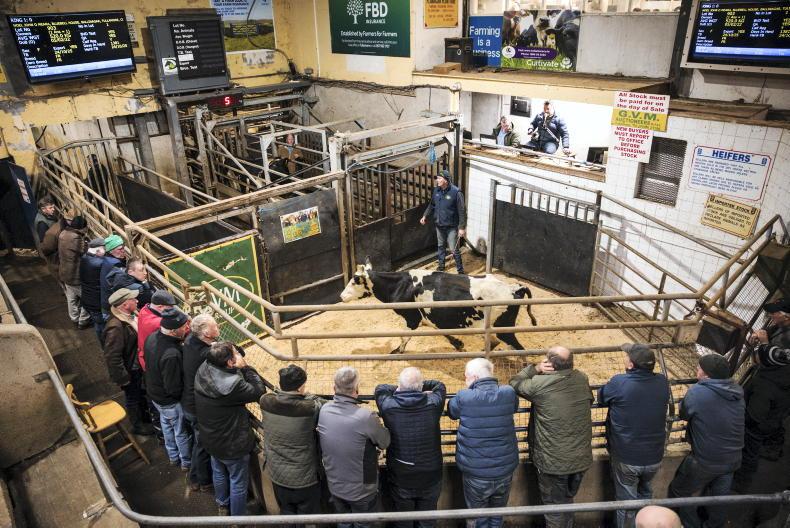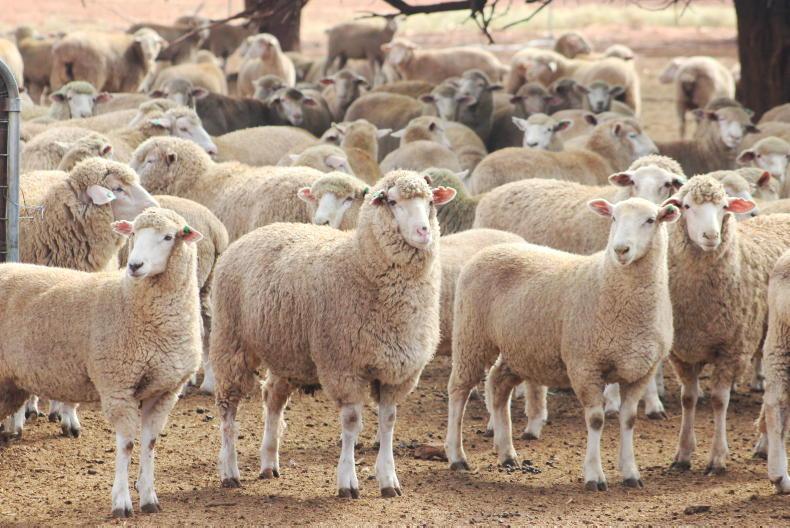China was the buzzword in Naas last week at the Bord Bia marketing seminar with almost every presenter at the seminar referring to the opening of the Chinese market to Irish beef as being one of the big positives of meat markets as we enter 2023.
Opening the conference, Minister of State at the Department of Agriculture Martin Heydon said: “Developing market access and identifying new opportunities for Irish product is a central theme in the Food Vision 2030 plan.”
Minister Heydon said: “China reopening its market to Irish beef is hugely positive for Irish farmers and I want to pay tribute to my Department’s staff and everybody that worked so hard across the industry to get this market open again.”
He announced a major trade mission to China in May 2023 to build on the positive news of market access for Irish beef to help Irish producers build relationships with Chinese customers.
Speaking via video from a hotpot restaurant in China, Bord Bia’s Conor O’Sullivan said: “The Chinese markets offer a huge opportunity to increase carcase value through the marketing of lower-value cuts, which may not be in as much demand in other countries.”
He did express concern around billions of people attending Chinese new year celebrations in the next few weeks and the impact that that could have on Covid-19 cases. “We are expecting a second wave of COVID-19 cases in February and that could temper demand for a few weeks but we are expecting more normal trading conditions from the second half of the year onwards.”
Speaking about the Chinese market, Gira’s Rupert Claxton said: “We are not there yet when it comes to full capacity in China.
“Restaurants are still operating at half capacity and we won’t see a full return to normal trading conditions until the second half of 2023.”
Also commenting on the Chinese access from a Department of Agriculture point of view, Sinead McPhilip, assistant secretary general at the Department of Agriculture and Food, said: “We are aware that the industry is fully prepared for Chinese access and we are also aware of various processors running ‘China Days’ for production during the time we were locked out of the market.
“I can’t stress the importance of having all paperwork correct for the Chinese market. Everything has to be right and they will be very strict on that.”
Reduced cattle supplies for 2023
Bord Bia’s Mark Zieg outlined a very positive outlook for beef markets in 2023.
Looking back at 2022, sales into the UK were up 15%, while sales into mainland Europe were up 26%, driven by a 55% sales increase in Italy and a 42% increase in France.
The average Irish beef price in 2022 was €5.04/kg, up 18% on 2021, the average UK price was €5.39/kg, up 10% on 2021, while the average beef price in Europe was €5.23/kg.
The 2022 national kill was up 7% to 1.82m head. Within that, the prime kill was up 5% or 65,000 head while the cow kill was up 14% or 59,000 head.
Commenting on the live export trade outlook, Mark Zieg said: “There was a real solid demand for calves, weanlings and store cattle right throughout 2022 and that is expected to continue into 2023.
“The longer-term outlook is challenging with particular pressure on the young calf export trade.”
Live exports finished up 16% in 2022 at 286,347 head exported. Irish cattle availability is expected to remain very tight for much of 2023, with a 5% reduction of cattle available for slaughter expected in quarter one of 2023.

Jim O’Toole, Bord Bia CEO, said: “Behind these very positive headline figures we have to acknowledge the many challenges that many companies are facing, including a global economic uncertainty driven by high inflation rates and increased cost of living, along with the war in Ukraine.”
This will drop to a 6% reduction in quarter two and then recover somewhat towards the end of the year.
The overall kill is expected to reduce by 3% to 4% in 2023 or 50,000 to 60,000 head.
Figure 1 outlines the average carcase weights for 2022. Carcase weights saw a drop of 9kg, or 2.6%, in 2022 driven by more and more cattle being of dairy beef origin and being slaughtered at a younger age.
Overall European beef production is expected to contract in 2023 with a 5.5% reduction expected between 2022 and 2027.
European beef consumption is expected to decline by 1% in 2023.
Inflation changing consumer choices
Consumer spending on meat products is trading downwards with chicken being the only exception in the last few months.
Consumers perceive chicken to be more versatile in terms of household usage, with some meats such as lamb trading down 18% in the last few months.
Bord Bia’s Grace Binchy and Danny Bowles outlined some interesting analysis in relation to a changing consumer landscape in 2022 and 2023.
More price-conscious consumers are spending more time shopping around, with 51% of Irish consumers shopping around in multiple stores in 2022 to get better value.
Consumers were also more concerned with buying value for money and essential items with discretionary spend down in 2022. This was all driven by a higher inflation rate reducing the spending power of consumers.
Steak cuts and roasting joints were further down the shopping list in 2022. There has been a big shift away from eating out in restaurants in recent months. There was a post-COVID-19 bounce but this has fallen back, with 70% of Irish consumers eating out less in restaurants in recent months.
Price is the main factor here affecting eating out; 70% in brand awareness is a good figure in terms of industry standards and the four key markets of the UK, France, Italy and Germany all above 65% with the UK coming in with the highest figure of 74%.
Brand awareness
This brand awareness is also being converted very quickly into actual purchases of product.
The brand awareness figure is of huge importance in terms of rolling out a PGI for beef, which will hopefully happen in 2023, with the Italian market being the likely target of an initial PGI push in 2023.
The seminar also outlined the most recent Bord Bia analysis on the meat alternatives market. When it comes to inflation, meat alternatives are not necessarily seen as good value, and a bit more of a risk as it’s more of an experiment or novelty.
Plant-based sales in the UK are up only 2.5% this year compared to a 40% and 14% sales increases in the last two years.
China was the buzzword in Naas last week at the Bord Bia marketing seminar with almost every presenter at the seminar referring to the opening of the Chinese market to Irish beef as being one of the big positives of meat markets as we enter 2023.
Opening the conference, Minister of State at the Department of Agriculture Martin Heydon said: “Developing market access and identifying new opportunities for Irish product is a central theme in the Food Vision 2030 plan.”
Minister Heydon said: “China reopening its market to Irish beef is hugely positive for Irish farmers and I want to pay tribute to my Department’s staff and everybody that worked so hard across the industry to get this market open again.”
He announced a major trade mission to China in May 2023 to build on the positive news of market access for Irish beef to help Irish producers build relationships with Chinese customers.
Speaking via video from a hotpot restaurant in China, Bord Bia’s Conor O’Sullivan said: “The Chinese markets offer a huge opportunity to increase carcase value through the marketing of lower-value cuts, which may not be in as much demand in other countries.”
He did express concern around billions of people attending Chinese new year celebrations in the next few weeks and the impact that that could have on Covid-19 cases. “We are expecting a second wave of COVID-19 cases in February and that could temper demand for a few weeks but we are expecting more normal trading conditions from the second half of the year onwards.”
Speaking about the Chinese market, Gira’s Rupert Claxton said: “We are not there yet when it comes to full capacity in China.
“Restaurants are still operating at half capacity and we won’t see a full return to normal trading conditions until the second half of 2023.”
Also commenting on the Chinese access from a Department of Agriculture point of view, Sinead McPhilip, assistant secretary general at the Department of Agriculture and Food, said: “We are aware that the industry is fully prepared for Chinese access and we are also aware of various processors running ‘China Days’ for production during the time we were locked out of the market.
“I can’t stress the importance of having all paperwork correct for the Chinese market. Everything has to be right and they will be very strict on that.”
Reduced cattle supplies for 2023
Bord Bia’s Mark Zieg outlined a very positive outlook for beef markets in 2023.
Looking back at 2022, sales into the UK were up 15%, while sales into mainland Europe were up 26%, driven by a 55% sales increase in Italy and a 42% increase in France.
The average Irish beef price in 2022 was €5.04/kg, up 18% on 2021, the average UK price was €5.39/kg, up 10% on 2021, while the average beef price in Europe was €5.23/kg.
The 2022 national kill was up 7% to 1.82m head. Within that, the prime kill was up 5% or 65,000 head while the cow kill was up 14% or 59,000 head.
Commenting on the live export trade outlook, Mark Zieg said: “There was a real solid demand for calves, weanlings and store cattle right throughout 2022 and that is expected to continue into 2023.
“The longer-term outlook is challenging with particular pressure on the young calf export trade.”
Live exports finished up 16% in 2022 at 286,347 head exported. Irish cattle availability is expected to remain very tight for much of 2023, with a 5% reduction of cattle available for slaughter expected in quarter one of 2023.

Jim O’Toole, Bord Bia CEO, said: “Behind these very positive headline figures we have to acknowledge the many challenges that many companies are facing, including a global economic uncertainty driven by high inflation rates and increased cost of living, along with the war in Ukraine.”
This will drop to a 6% reduction in quarter two and then recover somewhat towards the end of the year.
The overall kill is expected to reduce by 3% to 4% in 2023 or 50,000 to 60,000 head.
Figure 1 outlines the average carcase weights for 2022. Carcase weights saw a drop of 9kg, or 2.6%, in 2022 driven by more and more cattle being of dairy beef origin and being slaughtered at a younger age.
Overall European beef production is expected to contract in 2023 with a 5.5% reduction expected between 2022 and 2027.
European beef consumption is expected to decline by 1% in 2023.
Inflation changing consumer choices
Consumer spending on meat products is trading downwards with chicken being the only exception in the last few months.
Consumers perceive chicken to be more versatile in terms of household usage, with some meats such as lamb trading down 18% in the last few months.
Bord Bia’s Grace Binchy and Danny Bowles outlined some interesting analysis in relation to a changing consumer landscape in 2022 and 2023.
More price-conscious consumers are spending more time shopping around, with 51% of Irish consumers shopping around in multiple stores in 2022 to get better value.
Consumers were also more concerned with buying value for money and essential items with discretionary spend down in 2022. This was all driven by a higher inflation rate reducing the spending power of consumers.
Steak cuts and roasting joints were further down the shopping list in 2022. There has been a big shift away from eating out in restaurants in recent months. There was a post-COVID-19 bounce but this has fallen back, with 70% of Irish consumers eating out less in restaurants in recent months.
Price is the main factor here affecting eating out; 70% in brand awareness is a good figure in terms of industry standards and the four key markets of the UK, France, Italy and Germany all above 65% with the UK coming in with the highest figure of 74%.
Brand awareness
This brand awareness is also being converted very quickly into actual purchases of product.
The brand awareness figure is of huge importance in terms of rolling out a PGI for beef, which will hopefully happen in 2023, with the Italian market being the likely target of an initial PGI push in 2023.
The seminar also outlined the most recent Bord Bia analysis on the meat alternatives market. When it comes to inflation, meat alternatives are not necessarily seen as good value, and a bit more of a risk as it’s more of an experiment or novelty.
Plant-based sales in the UK are up only 2.5% this year compared to a 40% and 14% sales increases in the last two years.











SHARING OPTIONS